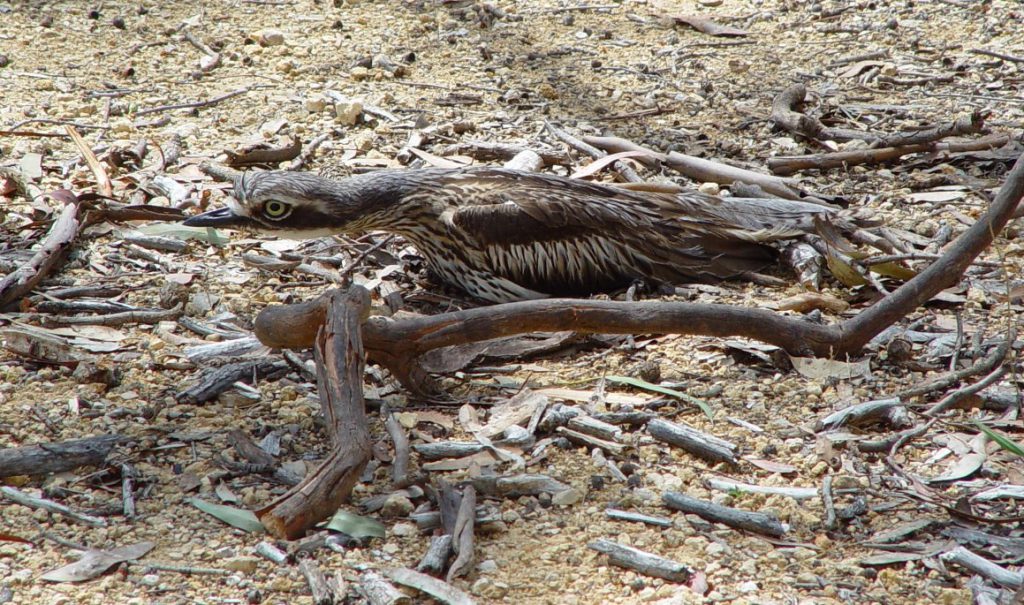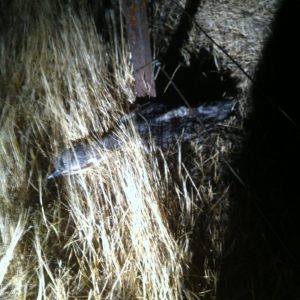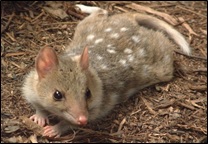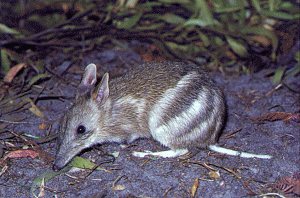Mainland forgotten fauna: Part 9 – Quolls, Curlews, Bandicoots and exploring different trajectories of decline…
Last week a couple of things happened that got me thinking again about our forgotten mainland fauna – so let’s pick up where we left off last time in Part 8, when we talked about ‘Shifting Baselines‘ and how our perception of the environment through time can deceive us.
First up, Jake Goodes from Parks Victoria sent through the really great photo shown right – taken in the past couple of years near Stawell (not far from Illawarra Nature Conservation Reserve).
It is an increasingly rare sighting of the humble Bush-stone Curlew – fast becoming another species of forgotten fauna in our part of the world, across Victoria and South Australia.

Secondly, after getting Jake’s email, I thought I’d do a bit of an experiment after giving a presentation about our missing fauna and the role of mammal predators in our ecosystems last week in the Victoria Valley (hosted by the local Landcare groups at the Mirranatwa Hall – by the way, thanks for a great evening!).
Sightings of the curlew in the southern Grampians are now rare and usually only represent an observation of a lone vagrant bird, but it didn’t used to be that way – and luckily we had a great range of ages in the room, from kids to people in their 70s or 80s.
So, when I asked everyone in the room (of, at a guess, about 60 people) how many people remembered hearing curlews call their haunting cry at night in the Valley in their lifetimes, about 8 or 10 hands went up. ‘They used to be common once down on the Wannon River bank under the gums‘ was just one comment.
Then I asked the same question about another threatened species of the area – the Eastern Barred Bandicoot – and a similar number of hands went up. In fact some sightings in the Valley occurred as recently as the early 1990s.
Which leads to me to the point of this story, which is that these two species of our grassy woodlands appear to have followed an eerily similar but comparatively slow trajectory of decline – a trajectory that is nothing at all like the many other species of ground-dwelling species we lost much earlier from the region.
Those species we lost early and very rapidly include the Eastern Quoll (referred to as the Native Cat) and the Bettong (often called Rat-kangaroo or Kangaroo-rat in old accounts).
Two key things we can now reconstruct from historic accounts that led up to that collapse were:
Firstly, the suppression of previously abundant and ubiquitous dingoes (based on direct quotes from early newspapers from the Dunkeld area):
1840s: Remembering his early station days near Dunkeld in the 1840s, John Mulcahy relayed a common story of the time when squatters first took up land for sheep grazing, by stating that:
“his duties were to guard the sheep from attacks by dingoes.”
1850s: However, by 1850, the dingo in the squatter’s pastoral runs around Hamilton is:
“fast yielding to strychnine”
1860s: In 1860, kangaroos have increased in the settled country but dingoes are still numerous:
“away back in the Grampians”
1920s: By 1921, there are:
“few dingoes left in this state (Victoria)”
Secondly, the simultaneous arrival and explosion of the fox population, probably facilitated by the eradication of dingoes, (also based on direct quotes from early newspapers from the Dunkeld area):
1891: around Hamilton and Dunkeld:
“We are daily hearing from correspondents of the increase of foxes in this district.”
1898:
“Foxes are now a much greater pest than dingoes in this district.”
1901:
“A week or two ago our Dunkeld correspondent referred to the prevalence of the fox pest in the district.”
The corresponding demise of the Eastern Quoll – from being the most abundant small native mammal predator to extinction in most of Victoria (except for a few places they held out longer, like in the stony rise lava-flow country) – was brutal and swift, as can be seen from these local accounts:
1862 in Dunkeld:
“now that the hot, dry weather is getting in, those troublesome little carnivorous wretches — the native cats— come in swarms every night to my dwelling, banqueting on the poor chickens, and keeping up their nocturnal orgies till the break of day, when they depart into the bush again to recruit their energies for the next attack; though numbers are nightly killed, still there appears no sensible diminution..”
1918 in Dunkeld:
“I seldom see one of these animals now. As a youngster I used to be afraid to go to bed, owing to the noise they made. I remember my father catching a large cask full one night. He sank the cask partly in the ground, and hung a dead kangaroo over it, as a decoy. He had a movable lid fixed in the cask, and he half-filled the cask with water. Next morning the cask was full of cats. In fact, I think it had got so full that many of the cats had got away again. We were living at Corea, near Dunkeld, at the time.”
1921:
“Regarding the native cat, they were very abundant in days gone by, but have practically disappeared over the whole of Victoria.”
Does anyone else out there wonder why it took so long for curlew and barred bandicoot numbers to decline, and why they continued to persist in so many areas – for so much longer – so long in fact that people can still remember seeing or hearing them in their lifetimes?
Did the crash in the rabbit population after the release of myxomatosis irreversibly increase predation pressure on these two species after the 1950s, or is it just that after 80 or 90 years, the slow demise finally became noticeable, when local populations started to blink out and off the map?
Whatever the explanation, one thing we know for sure – because the records don’t lie – is that both of these species held out for a long time. Now that means that the mathematical formula of their decline was very different to quolls and bettongs – and I think this is highly significant. Why, I hear you ask?
Well… if we can tweak that formula slightly, by experimenting with ways to increase survivorship rates ever so slightly, then – while yes, it will be incredibly hard work starting from our current position – it actually may not be completely impossible to get these species back into the landscape, outside of predator-proof fences.
The ways we might go about ‘tweaking the formula’ in our modified landscape, without our native predators keeping the ecosystem in balance, will be a subject for another time…!
Oh, and if anyone out there has memories or details of historic sightings of the Bush-stone Curlew or Eastern Barred Bandicoot in the southern Grampians especially (or southern Victoria or the South East of SA outside of where they are still hanging on) – no matter how long ago – please get in touch. We’d really love to collate these accounts while still within living memory of people today.
Please email the details (or your name and phone number and we’ll talk it over with you) to





